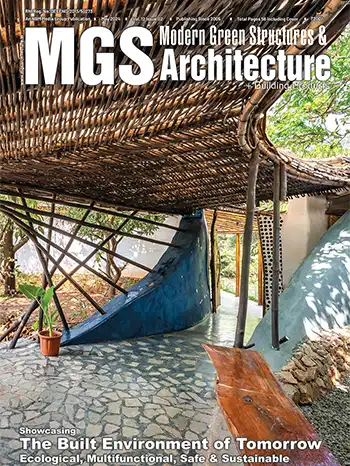Dow Corning: At the cutting edge of technical strength, performance and customer satisfaction

Dow Corning, as a company, has had a long innings in the glass industry. Hasn't it?
Dow corning is the largest global sealant manufacturer in the world. The company started manufacturing silicone in 1943 and brought in sealants in 1960. It has been associated with the glazing industry for 45 years.
How long have you been with Dow Corning?
Well, I have been with Dow Corning for the nineteen years. Of these, I have spent seventeen years on the technical side and two years in marketing.
The relationship between sealants and glass is strong. How do you see the position of glass as a building material in the future?
Silicon sealants and glass can be seen as partners. They both have similarities in chemistry and silicon is the only material that has a long-term adhesion to glass. Glass has a very long-term future in architecture, primarily because people like natural light. Designs may change and so may trend, but glass is likely to be around for very long. Within glass too, trend keep changing, For instance now the trend has been moving away from reflective glass that was very popular a few years ago to lightly tinted glass. Today, the focus is more on natural materials and in the North American and European markets, tinted glasses are losing popularity to clear glass.
How does the use of silicone sealant vary with the type of glass being used in a project?
The type of glass makes no difference. The use of sealant depends on the design of the building and how the glass is going to be fixed. If the glass is going to be fixed on the edges, more silicone will be used and if the glass is going to be framed, less silicone will be required. The silicone sealant is an important part of the design of the glazing.
What are your most popular products in India?
Well, the DC795 is a proven product that is being used for over 25 years now. It is popular in North America, Asia as well as Europe and comes in cartridges of its own. It is a one-part structural silicone sealant. Then there is an upgraded version that is the DC995, which has higher strength. It is a patented formulation that used a new polymer to create products for a longer shelf life. Usually, shelf life is affected by temperature and humidity. Because of its durability and longer shelf life, the DC995 is more suited to India and has been used in many A category projects here. These one-part sealants for structural glazing are relatively slow in curing and take one week or more to cure completely. This can be a problem in large projects. For this, two-part sealants like the DC993 are suitable, which has a 24-hour curing time. These are widely used in factory-based glazing works and for projects where large volumes of panels need to be completed per day. Another popular product used by fabricators and processors is the DC982, which is a two-part sealant used to bind between the joints of one glass and another in an insulating glass unit.
Do you also offer some services with the products?
We have a number of standard services that come free of charge with the product, like lab services that conduct testing for adhesion and compatibility. Wherever there is a requirement for a non-standard special service on a project, we bring in that expertise.
Do silicone sealants play a role in protection against earthquakes?
Several studies were done on curtain-walled buildings after the major earthquake in California in the early 1990s, which affected San Francisco and LA. The best performing buildings were those that were silicone sealed. In the curtain wall, the glass is held in place with silicone rubber. The rubber can take vibrations allowing the frame to move independently. Even in windows, silicone sealants used for fixing gave better performance. After 9/11 when bombing has becoming a serious concern, bomb blast testing for buildings was also done. Here too, it has been proven that silicone sealants can hold the glass in the frame when the building experiences vibrations from a blast.
What is your feeling for the growth of the company in India in the coming few years?
India has good potential for the future for Dow Corning. I have been coming to India regularly since 1991 and I see a distinct change in the way buildings are being designed and built. As a market, it is in the early growth stage, which means that awareness is growing and usage of sealants will go up. Also, with new types of buildings coming up—IT parks and call centers, a growing population and the boom in commercial buildings—the future looks good.
Is quality control a concern area for your products in India?
It is certainly a concern area, not just in India, but in many countries. As the industry grows, there are many small players in construction, with not much experience. We need to work closely with inexperienced players to ensure adherence to quality. Our recommendation usually is to stick to the guidelines that we give and to conduct a lab test for the design of each glazing project. There is a need for ongoing quality control on the job and we work with customers to ensure that adhesion is being achieved. We also recommend that the glazing should be done in a factory. We discourage site glazing, which is fixing the glass directly to the side of the building. Wherever possible, we urge the client to set up a factory on-site, which means they cordon off an area that is kept clean and the glazing is done horizontally first and then put up on the building.
What about technology acceptance by professionals—do you see that as a barrier for promoting your products?
Not at all. I think Indians like new technology. They are hungry for knowledge about new products and are excited about innovation.
Is the lack of training and inadequate standard development in India a concern for the sealant business?
They are not a major concern area, provided we take precautions at the site. Our clients need to be aware of the properties of the products. We tend to follow ASTM standards—that is the ASTM1184 standard for structural sealants. We have a technical manual which we recommend our clients follow for application as well as testing of our products.
What are your plans for in India in the near future, in terms of new products as well as expansion?
Usually, our products are developed in the United States and Europe and are used there for a few years. For Asia, we assess the need for products and then introduce them according to the specific needs. We are already strong in Asia and India. For India in particular, we have offices in major cities. We are also planning to put in a lab and a factory and increase our regional focus. We are bringing in professionals into this market who will identify the needs.
What would you like to say to the architects and engineering professionals who read this publication?
I would like to say that sealants are really important for architectural design. Architects and engineers must get involved in understanding and specifying products for their projects. They must specify sealants for glazing in buildings. Though we don't see the sealant and it comes up as a small part of the building cost, it plays a very large part in the performance of the building. If the correct sealant is used in the appropriate way, it contributes to the long-term success of the building, keeping building owners and tenants happy in the future. Construction professionals, especially specifiers, must resist the urge to change specifications to lower construction cost, at the cost of the performance of the buildings.
MGS Architecture January 2006
















